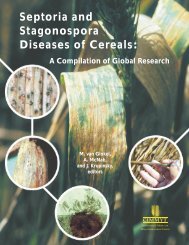Section 3 (Crop Management)
Section 3 (Crop Management)
Section 3 (Crop Management)
You also want an ePaper? Increase the reach of your titles
YUMPU automatically turns print PDFs into web optimized ePapers that Google loves.
Boonpradub and Kraokaw<br />
The objectives of this study were as follows:<br />
1) to compare the productivity of maize and second rice in farmers’ field,<br />
2) to study constraints to maize grown after rice,<br />
3) to evaluate yield potential of maize genotypes grown after rice,<br />
4) to determine the effect of planting date, plant density and fertilizer on growth and yield of maize<br />
grown in paddy fields.<br />
Materials and Methods<br />
A series of field studies were conducted for four years (1998 – 2002) on paddy soil at the farm of<br />
Phitsanulok Field <strong>Crop</strong>s Experiment Station (PSL FCES) and farmers’ field of Phitsanulok, Phitsanulok,<br />
Thailand (16 ο 47' N latitude, 100 ο 16 E' longitude) during dry season (December to April). The soil<br />
textures; namely loam, sandy loam and clay loam, at 0.20 m depth had a pH of about 5.5 – 6.0, organic<br />
matter about 1.5 – 2.0 % and most of the available nutrients were within normal range.<br />
Experiments<br />
Productivity of maize grown after rice as compared to second rice<br />
A field study was conducted at farmers’ field of Phitsanulok during dry season (October 2001 – April<br />
2002). Maize cv. Cargill 949 and rice cv. Suphanburi 1 were compared. Each plot was composed of 0.8<br />
ha. Data collection in both plots was yield, production costs in terms of labor cost and material costs.<br />
Problems and constraints to maize grown after rice<br />
Data was collected from 100 participating farmers in Phitsanulok by using questionnaires during a<br />
dry season from October 2001 to April 2002. Data was analyzed by using SPSS program. Statistical<br />
procedure was used in percentage.<br />
Yield trial of maize grown after rice<br />
A field experiment was conducted during the dry season of 1998 and 1999 at PSL FCES. A<br />
randomized complete block design with 4 replications was used. Twenty-one maize genotypes consisted<br />
of 16 commercial maize hybrids from a private sector and 5 genotypes (3 maize hybrid and 2 openpollinated<br />
varieties) from a public sector were evaluated. Data was analyzed by using IRRISTAT version<br />
3-93 and using DMRT for mean comparison.<br />
Response of maize grown after rice to planting date<br />
The field experiment was conducted at PSL FCES in 1999. A randomized complete block design with<br />
4 replications was used. A newly single cross hybrid of Thai Department of Agriculture (NS 72) was<br />
grown under different planting dates; starting from early November to mid February. Data was analyzed<br />
the same as in experiment 3.<br />
On-farm test of plant density for maize grown after rice<br />
An on-farm trial was conducted at the various farmers’ field during the dry season of 1998/1999.<br />
Maize cv. NS 72 was planted under two plant densities , i.e. 53,333 (0.75 x 0.25 m spacing with 1 plant<br />
hill -1 ) and 66,666 (0.75 x 0.20 m spacing with 1 plant hill -1 ) plants ha -1 . The Student t-test was used to<br />
perform statistical test for on-farm trial. Marginal rate of return (MRR) was used to compare economic<br />
return in both treatments (CIMMYT, 1988).<br />
- 308 -









